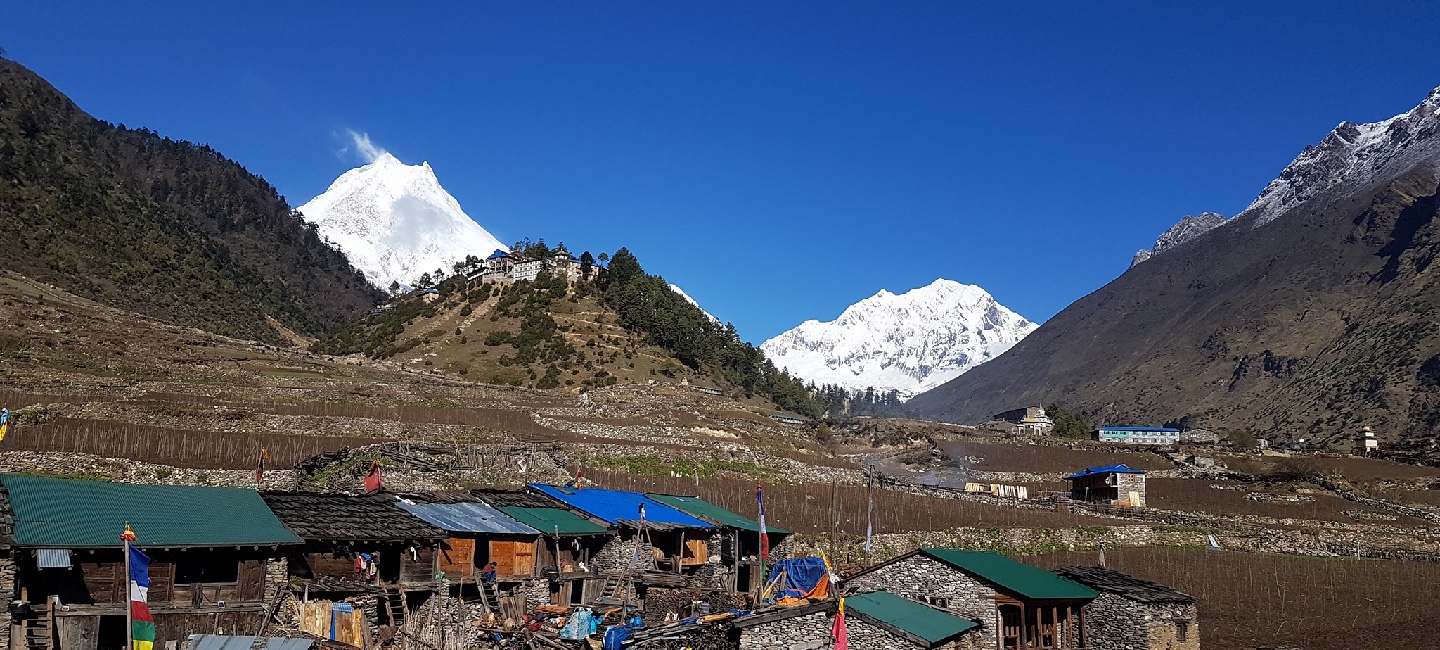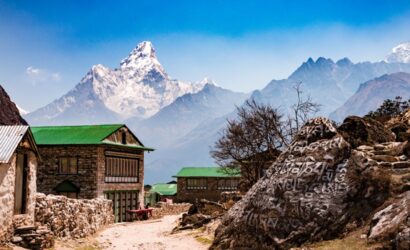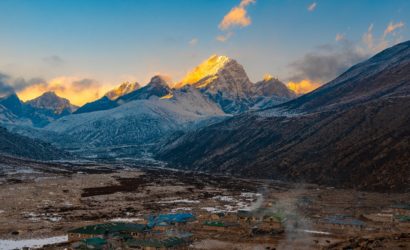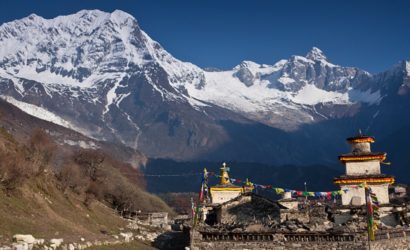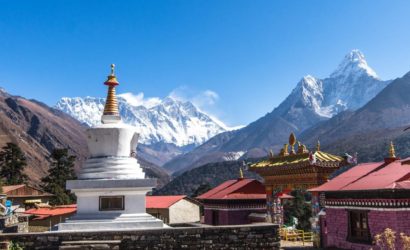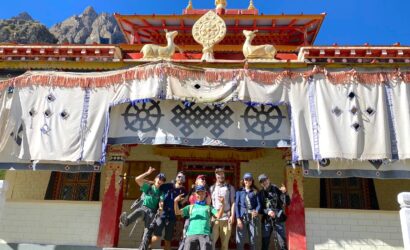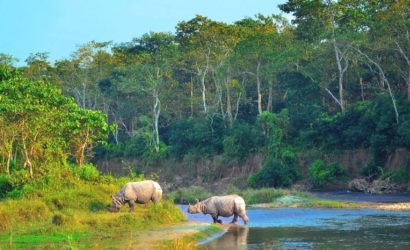If you are adventure seeker, just explore Nepal’s heart on the Manaslu Circuit Trek, encircling the world’s eighth-highest peak, Mount Manaslu. This trek unfolds raw natural beauty, cultural richness, and a challenging yet rewarding adventure in the majestic Himalayas.
Manaslu, known as the “Mountain of the Spirit,” offers a less crowded option compared to popular regions like Annapurna and Everest. Starting in Machha Khola, the trek takes you through varied landscapes, including terraced fields, dense forests, alpine meadows, and glacial moraines.
The trail highlights the majestic Himalayas and offers an immersive cultural experience as it passes through ancient villages of the indigenous communities like Gurung, Nubri and Tsum.
The Manaslu Circuit Trek stands out for its restricted entry, demanding a special permit. This rule guarantees a more private and genuine experience for trekkers. Along the route, they come across traditional Tibetan-influenced villages with vibrant prayer flags and intricate monasteries.
The friendly locals enhance the journey with their warm hospitality, providing insight into the distinctive customs and traditions of the Manaslu region. The trek culminates at Larkya La Pass, a demanding high-altitude crossing that treats trekkers to stunning panoramic views of nearby peaks, such as Mount Manaslu, Himlung Himal, and Annapurna II.
In essence, the Manaslu Circuit Trek offers a captivating journey, blending unexplored landscapes with authentic cultural experiences. Whether you’re an experienced trekker seeking a challenge or a nature enthusiast craving a pristine escape, this trek promises adventure, cultural discovery, and breathtaking Himalayan views.
Overview of the Manaslu Circuit Trek
If you’ve already visited Annapurna area, this trek can be a great option. It is a 14-day journey that begins at Soti Khola and ends at Besi-sahar and can be extended to 20 days with an additional side trek to the Tsum Valley or the Annapurna Circuit.
It is one of the most elegant of the 8000-meter giants, surrounded to the West by the Annapurnas and to the East by the Ganesh Himal.
Unlike the Everest Base Camp Trek, which attracts trekkers from all over the world, the Manaslu Circuit Trek typically sees less people along its route. It’s isolated and physically challenging, but it’s also culturally enriching and scenically gorgeous.
The route takes you from the steamy valleys with their rice and millet terraces to the mighty Budi Gandaki gorges with their blue river and beautiful waterfalls. Suspension bridges on the Manaslu trek are unparalleled in terms of length and height, and the seasonal monsoon often washes minor bridges away, leaving trekkers to walk on semi-submerged rocks.
This trek, which was only open to a maximum of 400 trekkers in 1992, has the feel of a pioneer expedition. If you want to experience hiking in the 1980s, the Manaslu Circuit Trek is a visual feast from start to end, but you better be in good shape.
You slowly make your way north to the snow-bound Larke La Pass near the Tibetan border. The altitude is an issue here, but it’s pretty much forgotten with the breathtaking views of Manaslu. Larke La pass at 5167 meters is generally snow-covered and icy. On the descent, micro crampons are often used. The trek to the pass begins at 3 AM in order to reach the highest point before the winds arrive, which normally arrive around mid-morning.
Looking back the way you came from the pass gives you a good view, but the most stunning view comes after leaving the pass and walking along a corridor to the west.
A massive glacial cirque appears into view. An incredible wall created by Cheo Himal, Himlung Himal, Nemjung, Gyaji Kang, and Kang Guru casts a stream of glaciers down, while Annapurna II rises ahead.
The view alone is worth the journey. Himalaya Discovery can plan an all-inclusive 14-day trek for you. Unless you wish to travel off route, when camping is the only option, the journey can be done in a teahouse.
Permits for Manaslu Circuit Trek
To trek in the Manaslu Conservation Area, obtain the necessary permits through a Kathmandu trekking agency before starting. Three essential permits are required. They are:
- Manaslu Restricted Area Permit
- Manaslu Conservation Area Project (MCAP Permit)
- Annapurna Conservation Area Project (ACAP Permit)
Special Restricted Area Permit for Manaslu (Manaslu RAP)
The Manaslu Restricted Area Permit (MRAP) is $100 per person for the first week (September to November), with an additional $10 per person for each subsequent week. From December to August, the permit is $75 per person, with an extra $7 per person for each additional week.
Manaslu Conservation Area Project (MCAP Permit)
Obtain the Manaslu Conservation Area Project (MCAP) permit for NPR 3,000 and the Annapurna Area Permit for the same amount, approximately USD 22. Additionally, purchase a TIMS card from the Kathmandu Tourism Board for NPR 2,000 to ensure a smooth journey.
Annapurna Conservation Area Project (ACAP Permit)
To secure the necessary permits for the Manaslu Circuit Trek, submit an application at the Nepal Tourism Board in Kathmandu. Include a photocopy of your passport, valid visa, trekking agency’s tax clearance guarantee, a list of trekker names, and insurance documents for guides and staff.
Guided Trek And Porters
Guides and porters are essential for a safe Manaslu Circuit Trek. Due to incidents of missing and injured trekkers in Nepal’s remote areas, a new law effective from April 1, 2023, mandates the hiring of a guide to improve trekker safety in unfamiliar terrains.
To embark on the trek, you need a certified guide with extensive local knowledge. Guides provide valuable insights on local people, traditions, culture, and the history of the Manaslu region. Their daily charge is typically $30-$35, depending on professionalism and additional services.
For this lengthy journey, porters are very important. They carry necessary gear, alleviating the challenge for individuals. This enables trekkers to enjoy the Manaslu region’s scenery, immerse in the culture, and interact with locals. Porters charge $22 to $30 daily, depending on their ability to handle heavy items.
Difficulty Level of Manaslu Circuit Trek
The Manaslu Circuit Trek offers breathtaking scenery and cultural experiences, making it a rewarding challenge. While good fitness is essential due to high altitudes and steep terrain, no special skills or equipment are required, as the trail is non-technical.
The trek peaks at 5,106 m (16,752 ft) at Larkya La pass, posing a risk of altitude sickness. To mitigate this, proceed slowly, stay hydrated, and be vigilant for symptoms. The trail includes narrow cliff edges, but no ropes or ladders are required. Trekking poles can aid balance and alleviate knee strain.
This trek is moderately challenging, suitable for those who exercise regularly and can comfortably hike 6-8 hours daily. However, be cautious about altitude effects; include an extra rest day in your itinerary for acclimatization.
When To Do Manaslu Circuit Trek?
Spring (March to May)
Spring in Nepal, spanning from March to May, brings a host of delights. The season is marked by vibrant colors and crystal-clear mountain views. Blooming rhododendron forests along the Manaslu Circuit enhance the beauty of the expedition, while lush greenery transforms the landscape into breathtaking scenery.
Spring offers ideal weather conditions with a moderate temperature averaging 18°C in the daytime and around -12°C at night. Minimal precipitation and snowfall make it convenient for trekkers to navigate remote trails to reach Larke La Pass. It ensures an easy getaway to the destination.
Autumn (September to November)
Fall is an ideal time for trekking the Manaslu Circuit. It offers stable weather conditions with moderate temperatures ranging from around 20°C during the day to approximately 5°C at night. This season is conducive to trekking and climbing the snow-covered peaks, much like in Spring.
During Autumn, the clear skies offer a great chance to appreciate breathtaking views of Mount Manaslu, Himchuli, and others. Nepal’s festive season in Autumn, with celebrations like Dashain and Tihar, leads to travel agency discounts. These agencies support cultural immersion and activities in the Manaslu Region.
Manaslu Circuit Trek Transportation
To begin the journey, travel 160 km from Kathmandu to Macha Khola via Soti Khola. It takes about 7 hours by private jeep and 8 to 9 hours by local bus. The first day of the trek is an off-road adventure ride.
At the end of the trek, you will drive 6 hours from Dharapani in a Jeep. Later, you will change to another Jeep or local bus for a 7-hour drive to Kathmandu.
Accommodations for the Manaslu Trek
Manaslu Circuit Trek is a lodge-based trek. Every night, you will sleep in the tea house, which has two single beds. Toilets are mostly shared and can be located outside of guesthouses. Only the dining area has heating. During the trip, you will stop for lunch at teahouses.
WIFI and phone service on the Manaslu Area
Wifi is available in the most of guesthouses. If you want to contact with family and friends back home, tea houses have SAT phones. They cost a little more money to use. In the Manaslu region, Nepal Telecom (NTC) has better coverage than Ncell.
Detailed Itinerary
To embark on the Manaslu Circuit Trek, you’ll arrive in Kathmandu at Tribhuvan International Airport. We will pick you up and take you to the respective hotel.
This day you will spend your entire day / evening in Kathmandu. You can wander around the city to get familiar with the surrounding. There are varieties of religious and fun places where you can hang out and enjoy the time.
Today, it’s free for sightseeing in Kathmandu. We prepare your trekking permits for the Manaslu Circuit.
You may wish to Durbar Square in the heart of the old town, where the former Royal Palace with its beautiful woodcarving. The entire area is a maze of temples and images.
The small alleys leading away from the square in all directions, filled with an incredible variety of shops and stalls. Some of these sites are World Heritage Sites, such as the historic Patan Durbar Square, the famous Monkey Temple Swayambhunath, and the Buddhist Shrine Buddhanath, one of the world’s largest stupas.
Today there will also be a trip briefing and gear check. There will be time today if you need to rent or buy equipment locally.
We will begin our Manaslu Circuit Trek by departing from Kathmandu Valley and heading to Machha Khola, situated at an elevation of 900 meters.
The picturesque 8-9 hour journey from Kathmandu to Machha Khola will treat you to breathtaking views of terrace fields, mountains, and rivers, passing through notable places like Dhadingbesi and Arughat.
Today, we’ll trek to Jagat at 1340 meters, enjoying stunning views along the way. After a brief stop in Kholabesi, we’ll head to Tato Pani, a natural hot spring.
Crossing the Budhi Gandaki River via a suspension bridge, passing through Dobhan village, and crossing another bridge over Yaru Khola, we’ll reach Jagat. The trek takes about 6 hours from Machha Khola. We’ll spend the night at a tea house in Jagat.
Today, we’ll embark on a 6-hour trek from Jagat to Deng. Starting with an early morning breakfast in Jagat, we’ll journey through Salleri, a Buddhist settlement, and trek past Philim and Ekle Bhatti before reaching Lokpa. Enjoying breathtaking views of the Himalayas, including Manaslu, we’ll continue uphill to Nyak and Nyak Phedi.
It takes approximately 1.5 hours from Nyak Phedi to reach Deng, where we’ll spend the night at a tea house.
On the sixth day of the Manalsu Circuit Trek, we’ll journey from Deng Village to Namrung. Starting with a climb to Rana Village and reaching Bhimphedi at 2130 meters, we’ll continue towards Serong Khola and Ghap, enjoying stunning views of snow-covered mountains and traditional villages along the way.
Descending through a bamboo and Rhododendron-filled valley, we’ll eventually reach Namrung Village, where we’ll spend the night at a local tea house.
Our objective today is to trek 7 hours to reach Sama Gaon from Namrung. The trail follows the Budi Gandaki River, taking us through Lihi, a settlement about one hour from Namrung. As we ascend through the Buddhist settlement, the path features green terraced fields and dense forests. After reaching Lihi and Sho Village, renowned for chortens, mani walls, and prayer flags, we proceed with our hike.
From Sho, it’s just an hour’s walk to Lho Village, where we’ll stay at a tea house. Continuing from Lho Village, we head towards Sama Gaun, starting on the right side of the river bank and reaching Shyala Village in about an hour.
The uphill hike offers breathtaking views of Phungi, Himal Chuli, and Manaslu mountains, highlighting the rich Buddhist culture of the region. A significant landmark is the ancient Sama Gaon Monastery.
On the 8th day of our Manaslu Circuit Trek, we will acclimatize to adapt into the changing altitude. To excel at high altitudes, be in good physical condition. On the third day, spend a full day acclimatizing in Sama Gaon; explore nearby areas. Stay hydrated, eat well, and rest at a tea house for the day.
Today’s trek in the Manaslu Circuit is brief, taking about 3 hours from Sama Gaun to Samdo. We’ll begin early, navigating rocky terrain towards Samdo, passing by Kongma Kharka, a high-altitude pastureland.
On Day 10, we navigate through rugged terrain from Samdo to Dharmasala. Initially, we reach Larkya Bazaar within an hour from Samdo, and then proceed towards Dharmasala. In winter, the trail can be technically challenging due to slippery snow, but during other seasons, it’s more manageable.
The journey from Samdo to Dharmasala typically takes about 4 hours. Upon arrival, accommodation will be at a tea house.
On the eleventh day, we’ll journey to Larkya La Phedi and Larkya La Pass, then descend to Bimthang. Starting from Larkya Phedi, we’ll climb Nepal’s high-altitude pass, Larkya La, reaching 5,160 meters above sea level, before returning to Larkya Phedi.
From Larkya La Phedi, we’ll tackle a challenging trail to Bimthang (3720 m), passing four lakes and ascending a steep pass. Despite the difficulty, the beauty of the surroundings will provide a calming and rejuvenating experience. Subsequently, we’ll traverse grassy moraine and a small hamlet on our way to Bimthang.
From Bhimtang, we will descend through the downhill trail towards Ghowa, where we will be staying overnight. We start early in the morning and then reach Hampuk village, from where the scenery of the deep gorges and green hills are visible.
From there, we will traverse Yak Kharka and reach Kharche before reaching Ghowa. We will descend alongside the trail of Dudh Khola enjoying the scenery of lush green forests of rhododendron and pine trees.
From Ghowa, we will embark on a 5 to 6 hours long trek to reach Dharapani. For that, we must traverse the settlements, including Tilje and Thonje. These are the Buddhist settlements rich in ancient Buddhist culture and significance.
The mani walls, chortens, monasteries, and prayer flags will give us insights into the practice of this religion.
There comes a checkpost near Thonje and after crossing it, we will catch a remote trail featuring dense forests. The trail leads us to Dharapani. From Dharapani, we will take a jeep ride to reach Besi Sahar and stay at a guest house overnight.
From Besisahar, we will drive back to Kathmandu, which takes around 5 hours. We will enjoy the scenery of Trishuli River, lush green forests, waterfalls, and terraced fields as we drive through the Prithivi Highway.
You can either stay back in Kathmandu today and enjoy a free day or leave for your respective countries.
It’s time to say goodbye to Nepal. Enjoy your final moments in Kathmandu by having breakfast in a café, taking a city stroll, and/or shopping for souvenirs.
A representative will meet you at your hotel and transfer you to the airport to catch your return flight home. It’s good to be at the airport at least two and half hours prior to departure.

